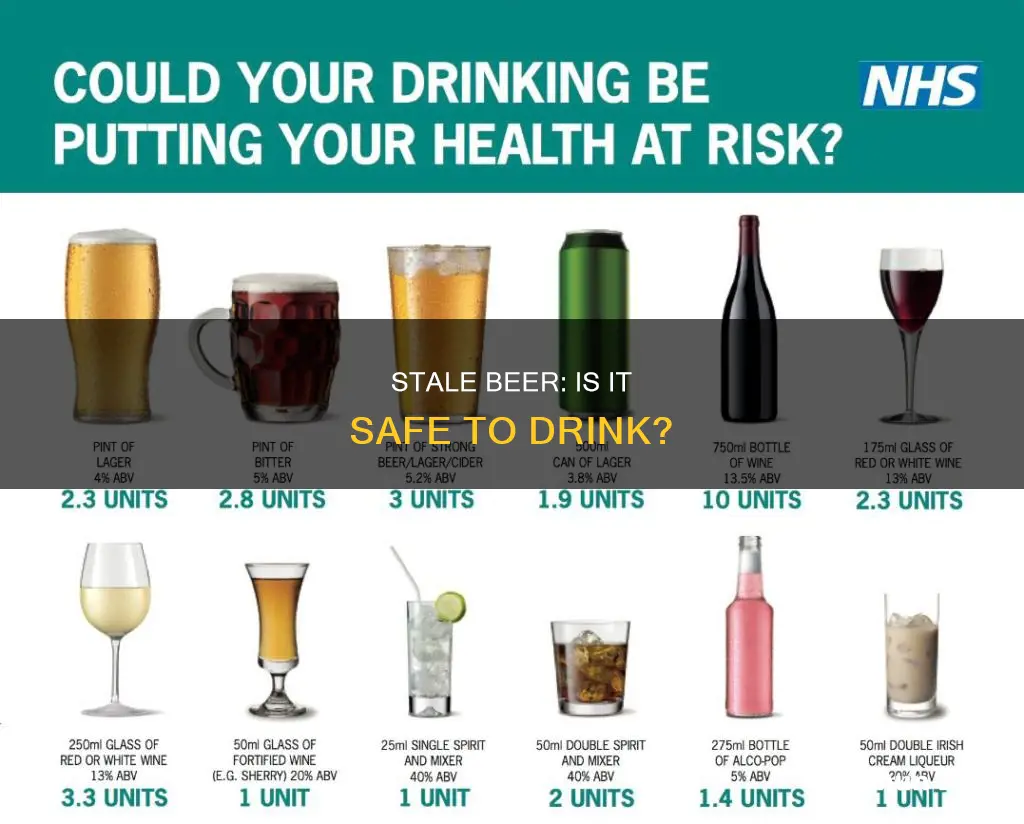
Stale beer is generally safe to drink, but it might not taste very nice. Beer is resistant to spoiling because the fermentation process used in brewing, as well as its low pH level and alcohol content, make it difficult for microorganisms to grow. However, beer can still go off if the seal is broken, or if it has been exposed to heat or light, in which case it may taste like wet cardboard, or be overly sweet or vinegary.
| Characteristics | Values |
|---|---|
| Is stale beer safe to drink? | In most cases, yes, it is safe to drink stale beer. |
| Will it taste good? | No, stale beer will have a flat, malty, sweet, vinegary, or bitter taste. |
| What causes beer to go stale? | Exposure to light, oxygen, and heat. |
| How to prevent beer from going stale? | Store beer in a cool, dark place, preferably a refrigerator, and consume within three to six months. |
| Does the type of beer matter? | Yes, craft beer bottled in dark glass or cans can last for about a year, while beer in clear bottles degrades faster. Beer with higher alcohol content tends to last longer. |
What You'll Learn
- Stale beer is safe to drink but it may taste unpleasant
- Beer is resistant to spoiling because of the fermentation process
- Beer should be stored in a cool, dark place to prevent it from going stale
- Beer can be stored in the fridge for up to two or three years
- Beer stored in clear bottles degrades in quality more quickly

Stale beer is safe to drink but it may taste unpleasant
That being said, stale beer will not taste good. Over time, the beer will oxidise, both from oxygen introduced during packaging and through the release of oxygen from compounds previously oxidised in the beer. The oxygen causes the beer to stale, producing tones of sherry, paper, and cardboard. Hop aromas are muted, and hop beta acids oxidise to produce an unrefined bitterness. Other forms of staling can lead to a soapy taste.
Generally, the higher the alcohol content of the beer, the less concerned you need to be with its use-by date. Beers with higher alcohol by volume have a longer shelf life. Beers stored in clear bottles will degrade in quality more quickly, whereas beers stored in dark bottles or cans will last longer.
To prevent beer from going stale, keep it in a cool, dark place, preferably the refrigerator. If you're storing at room temperature, make sure the sun can't reach it. Leave your beers standing upright, as this allows for less exposure to oxygen than when the bottle or can lies on its side.
Beer Drinking: A Sleep Inducer or Myth?
You may want to see also

Beer is resistant to spoiling because of the fermentation process
The fermentation process also produces hop iso-alpha acids, which have antibacterial properties, particularly against Gram-positive bacteria. These compounds dissipate the pH gradient across the bacterial cell membrane, reducing the proton motive force and hindering nutrient uptake, ultimately leading to cell death. Additionally, the low oxygen content and limited nutrients in beer further inhibit microbial growth.
While most microorganisms cannot survive in beer, some have adapted to thrive in this environment. These microbes can spoil beer by producing undesirable odors, such as hydrogen sulfide (a rotten egg smell), and creating off-flavors like diacetyl (a buttery taste). They can also affect the beer's turbidity and attenuation rates.
Lactobacillus, Pediococcus, and Brettanomyces bruxellensis are common beer spoilers. Lactobacillus and Pediococcus, which are Gram-positive bacteria, can tolerate high temperatures and acidity. They can cause the beer to taste sour and form a silky turbidity. Pediococcus can also create a viscous "rope consistency" in the beer. Brettanomyces bruxellensis, a wild yeast strain, can produce excess phenolic compounds and carboxylic acids, resulting in a "musty" aroma and a "horsey" off-flavor.
To minimize the risk of spoilage, brewers must implement regular microbial detection throughout the brewing process. Maintaining healthy environments for desirable microorganisms while preventing the growth of spoilage microbes is crucial. Techniques such as flash pasteurization, sterile filtration, and the use of compounds like Nisin can help inhibit the growth of spoilage microorganisms. Proper storage conditions, including refrigeration, minimizing light exposure, and keeping bottles upright, are also essential to prevent spoilage and maintain beer quality.
Phentermine and Alcohol: Safe to Drink Beer Later?
You may want to see also

Beer should be stored in a cool, dark place to prevent it from going stale
Beer is a perishable product that can go stale, but it won't make you sick. The organic compounds that give beer its distinctive smell and taste can be affected by exposure to light, oxygen, and heat. To prevent this, it's important to store beer in a cool, dark place.
Oxygen interacts with the compounds from malt, yeast, and hops, causing oxidation and a papery taste. This process is accelerated by heat, so it's best to store beer in a refrigerator. Major fluctuations in temperature, such as going from an ice-cold cooler to a hot car, can also negatively impact the taste of beer.
UV light from the sun can also cause beer to develop a skunky odour and taste. Hop compounds are especially sensitive to light and can become "light-struck", resulting in an unpleasant flavour. That's why beer is usually packaged in dark bottles or aluminium cans, which help block out UV rays.
By storing beer in a cool, dark place, you can help maintain its freshness and prevent it from going stale. This could be in a refrigerator, a cellar, a garage, or a pantry—anywhere that is cool and shielded from direct sunlight.
Beer and Sleepless Nights: Is There a Link?
You may want to see also

Beer can be stored in the fridge for up to two or three years
Beer is a beverage that has been enjoyed for centuries, but how long can it be stored before it turns stale? Well, you'll be glad to know that beer can be stored in the fridge for quite a long time—up to two or three years past the expiration date! This is because the fermentation process used in brewing, along with its low pH and alcohol content, creates an environment that is unfriendly to microorganisms. So, even if your beer has been sitting in the fridge for a while, it's unlikely to make you sick.
However, it's important to note that the taste of beer does change over time. So, while it may be safe to drink, it might not taste as good as a fresh brew. This is due to the oxidation process, where oxygen interacts with the compounds from malt, yeast, and hops, resulting in a disappointing papery or vinegary taste. Heat and light exposure can also affect the taste, with UV rays from sunlight creating a chemical reaction that breaks down the flavour components, resulting in a skunky smell and taste.
To ensure your beer stays fresh for as long as possible, it's best to store it in a cool, dark place, preferably the refrigerator. Keeping beer at a temperature between 45°F and 55°F will help to prolong its shelf life. Additionally, it's important to store beer upright to minimize contact with oxygen and avoid exposing it to direct sunlight.
While drinking expired beer is generally safe, there are some rare situations where it's best to throw it out. If your beer has lost its fizz, it's a sign that the seal was broken and the flavour will be affected. Additionally, if a beer develops a vinegary taste, it's an indication that bacteria have gotten in and it's no longer safe to drink.
So, if you're wondering whether that old beer at the back of your fridge is still good, chances are it's probably safe to drink, but it might not taste as refreshing as you remember.
Battling Beer Addiction: My Daily Struggle with Alcohol
You may want to see also

Beer stored in clear bottles degrades in quality more quickly
Beer is a delicate beverage, and there are many factors that can impact its flavour and quality. One of the most important considerations is the container in which the beer is stored. While clear bottles may be aesthetically pleasing and allow for better light transmission, they can negatively impact the beer's quality. Beer stored in clear bottles degrades more rapidly than beer stored in opaque containers.
The primary reason for this rapid degradation is the increased exposure to UV light. Ultraviolet rays can interact with the hops in the beer, creating an unpleasant chemical reaction that results in a skunky odour and taste. This phenomenon is known as "light-struck" beer, and it is a common issue with lighter beers such as lagers and pale ales. The clear bottles do not offer sufficient protection against UV rays, allowing the light to penetrate and alter the beer's chemical composition.
Additionally, the oxidation process is accelerated by light exposure, causing the beer to become stale more quickly. Oxygen interacts with the compounds from malt, yeast, and hops, leading to oxidation and the development of a papery or cardboard-like taste. This oxidation process is inevitable, even with modern packaging techniques, as a small amount of oxygen will inevitably be present in the sealed container.
The adverse effects of light exposure on beer quality are well-known, and brewers have traditionally used brown bottles to mitigate this issue. Brown bottles are made from amber glass, which has a higher iron content and provides superior UV protection. This darker glass effectively blocks out harmful UV rays, helping to maintain the beer's freshness and flavour.
However, it is important to note that even with proper storage in brown bottles, beer can still go bad. Other factors such as temperature, oxygen exposure, and time also contribute to the degradation of beer. Heat, in particular, accelerates the oxidation process, making refrigeration an essential factor in preserving beer's quality.
In summary, beer stored in clear bottles is more susceptible to quality degradation due to increased UV light exposure. This exposure leads to chemical changes in the beer, resulting in undesirable flavours and aromas. To maintain optimal beer quality, it is recommended to store beer in opaque containers, such as brown bottles or aluminium cans, and to keep it refrigerated.
Beer and High Blood Pressure: Safe to Drink?
You may want to see also
Frequently asked questions
Yes, drinking stale beer is safe. Beer is either pasteurized or filtered to eliminate bacteria, making it extremely resistant to spoiling.
Stale beer will have a degraded flavour. It may taste flat, overly sweet, or vinegary.
Beer lasts about 5 to 9 months beyond the expiration date listed on the label at room temperature. In a refrigerator, beer can last up to an additional two or three years.
Keep your beer in a cool, dark place, preferably the refrigerator. If you're storing at room temperature, make sure it's not exposed to sunlight.







